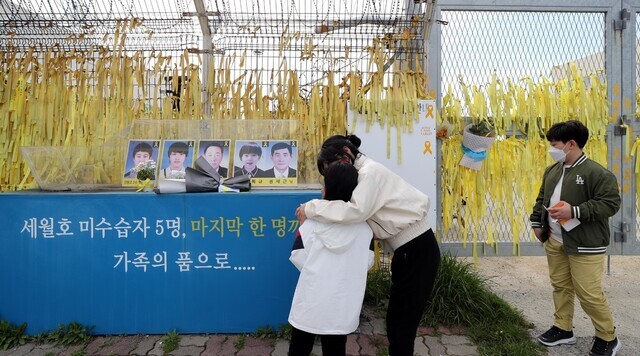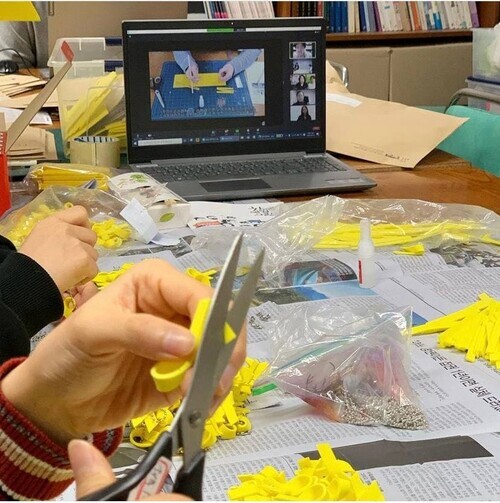hankyoreh
Links to other country sites 다른 나라 사이트 링크
Stories of those who still wear yellow ribbons

“Why are you still wearing that ribbon?”
Shim, a 17-year-old high school student, got the message on social media after posting a selfie showing a yellow ribbon attached to his mask, leading up to the seventh anniversary of the sinking of the Sewol ferry Friday.
Shim got the ribbon back in April 2020, when he signed a petition demanding the truth about the Sewol accident. He’d kept the ribbon on his backpack until two weeks ago when he pinned it to his mask.
Insulting comments have been posted on Shim’s social media accounts about the ribbon, and friends have asked why he keeps it on his backpack. But he doesn’t intend to take it off.
“I’m determined not to forget about the Sewol tragedy. I hope that someone will see the ribbon on the street and be reminded of the tragedy.”
While seven years have passed since the accident, many people still wear the yellow ribbon or use it as their social media profile picture. Just like Shim, they take it in stride when others want to know why they’re still wearing the ribbon.
On Thursday, the day before the anniversary of the ferry sinking, the Hankyoreh spoke with seven people who still wear the yellow ribbon. When asked why they feel such a close connection with the ribbon, they spoke of solidarity and memory and of demanding answers to lingering questions.
These people said they can’t take off the ribbon because the issue still hasn’t been resolved, and because Korean society is still too callous about safety issues.
“I was taking care of my baby at the time of the accident, so I couldn’t help out directly. Even after that, my child was too young for me to do much. I see the yellow ribbon as being the least I can do,” said Lee Won-woo, 40, who wears the ribbon on her purse.
“The Sewol victims’ families still aren’t able to return to normal. Seven years later, we still don’t have a decent report detailing exactly what happened, and the people responsible haven’t been fully prosecuted,” Lee said, explaining that she wears the ribbon as an ongoing call for change.
“When people die of overwork or there’s some other fatal accident, people make commemorative ribbons to show their commitment to resolving the issue. In the same way, I wear the yellow ribbon as a small token of my commitment to finding a solution to the Sewol issue,” said Byeon Hui-yeong, aged 53.
Other people see the yellow ribbon as a way to sustain memories of the Sewol tragedy. One such person is Lee Ae-hyeong, 42, who works as a volunteer at a yellow ribbon workshop in Seoul’s Seochon neighborhood.
“I thought we’d have a full accounting of the facts of the Sewol tragedy when a new president came to power, but that didn’t happen. Seeing the Sewol issue getting exploited for political ends suggests that people want to forget about it. I became a volunteer to do my part to help people remember.”
“[The ribbon] expresses my commitment not to forget,” agreed Ham Se-eun, aged 20.

This determination not to forget leads to solidarity. “I saw a media interview where the Sewol victims’ families said that seeing people wearing the yellow ribbon was encouraging since it showed that people sympathized with them. Ever since then, I’ve never taken it off,” said a 32-year-old surnamed Kim.
“If I someday pass by the victims’ families, I hope the sight of the ribbon will bring them some small measure of consolation and strength.”
Koreans who wear the yellow ribbon are worried that, as time goes by, more people will forget about the Sewol ferry or get irritated with those who still remember.
A 32-year-old surnamed Park recalled a disturbing experience when a middle-aged man accosted her on the street and demanded to know why she was still wearing the ribbon on her bag.
“I calmly told him it was none of his business and went on my way, but inside I was upset. There are still people who can’t forget about the tragedy, and I’m afraid that those who commemorate the tragedy will come under more criticism.”
While one might expect that Sewol memorials would be overshadowed by COVID-19 this year, there’s still strong interest in events on the seventh anniversary.
Kim Hyo-seon heads up the civic participation team with People’s Solidarity for Participatory Democracy, which distributes kits for putting together yellow ribbons.
“We weren’t able to assemble the ribbons in person because of COVID-19, so we’ve been mailing out assembly kits to people who request them. 440 people ordered 25,000 kits, which is twice the number of orders we got last year,” Kim said.
By Lee Jae-ho, staff reporter
Please direct comments or questions to [english@hani.co.kr]

Editorial・opinion
![[Column] The state is back — but is it in business? [Column] The state is back — but is it in business?](https://flexible.img.hani.co.kr/flexible/normal/500/300/imgdb/original/2024/0506/8217149564092725.jpg) [Column] The state is back — but is it in business?
[Column] The state is back — but is it in business?![[Column] Life on our Trisolaris [Column] Life on our Trisolaris](https://flexible.img.hani.co.kr/flexible/normal/500/300/imgdb/original/2024/0505/4817148682278544.jpg) [Column] Life on our Trisolaris
[Column] Life on our Trisolaris- [Editorial] Penalties for airing allegations against Korea’s first lady endanger free press
- [Editorial] Yoon must halt procurement of SM-3 interceptor missiles
- [Guest essay] Maybe Korea’s rapid population decline is an opportunity, not a crisis
- [Column] Can Yoon steer diplomacy with Russia, China back on track?
- [Column] Season 2 of special prosecutor probe may be coming to Korea soon
- [Column] Park Geun-hye déjà vu in Yoon Suk-yeol
- [Editorial] New weight of N. Korea’s nuclear threats makes dialogue all the more urgent
- [Guest essay] The real reason Korea’s new right wants to dub Rhee a founding father
Most viewed articles
- 1[Column] Why Korea’s hard right is fated to lose
- 2Amid US-China clash, Korea must remember its failures in the 19th century, advises scholar
- 3[Column] The state is back — but is it in business?
- 460% of young Koreans see no need to have kids after marriage
- 5AI is catching up with humans at a ‘shocking’ rate
- 6Hybe-Ador dispute shines light on pervasive issues behind K-pop’s tidy facade
- 7Japan says it’s not pressuring Naver to sell Line, but Korean insiders say otherwise
- 8S. Korean chaebols comprise 84% of GDP but only 10% of jobs
- 9[Column] Can Yoon steer diplomacy with Russia, China back on track?
- 10Gangnam murderer says he killed “because women have always ignored me”